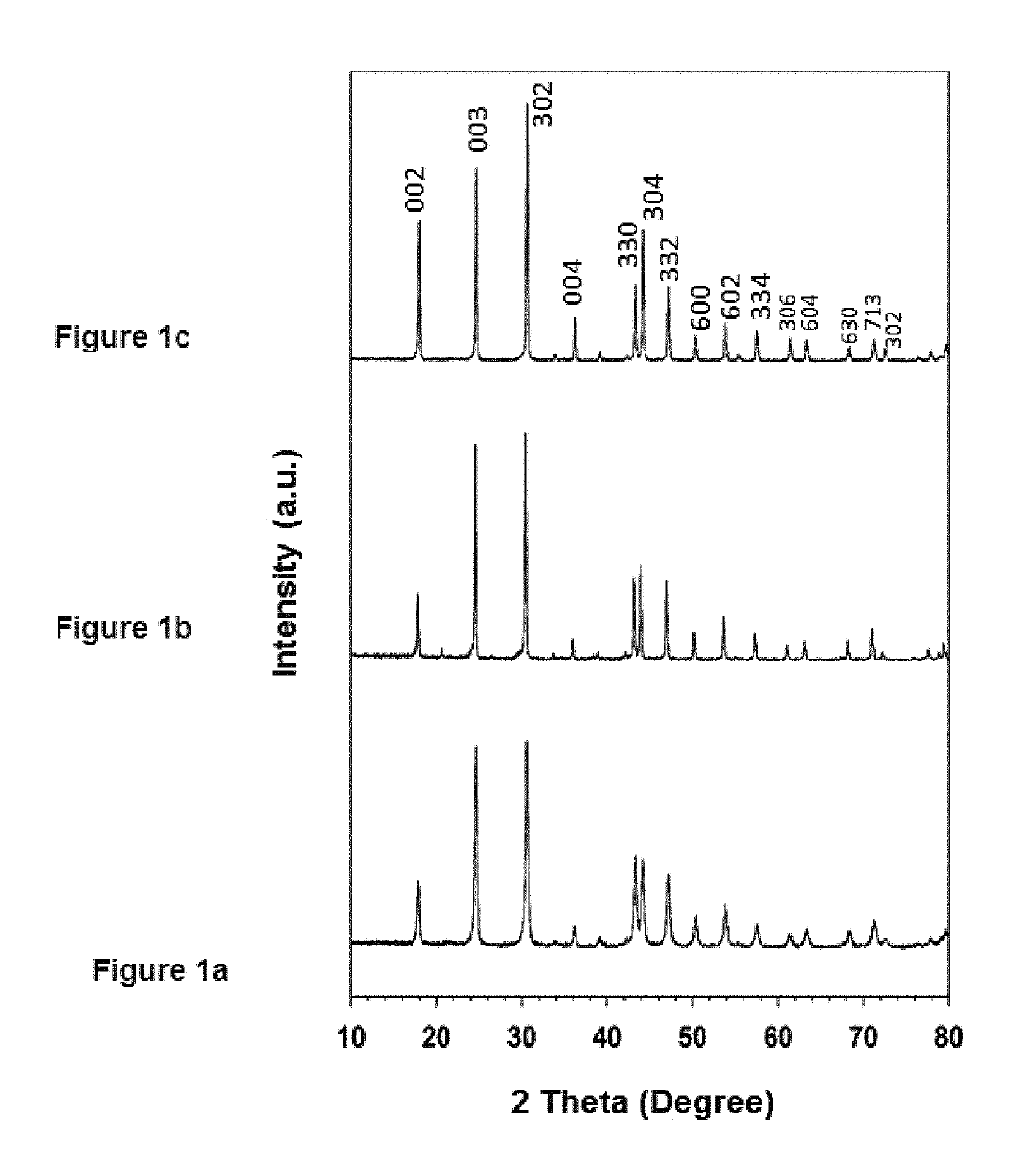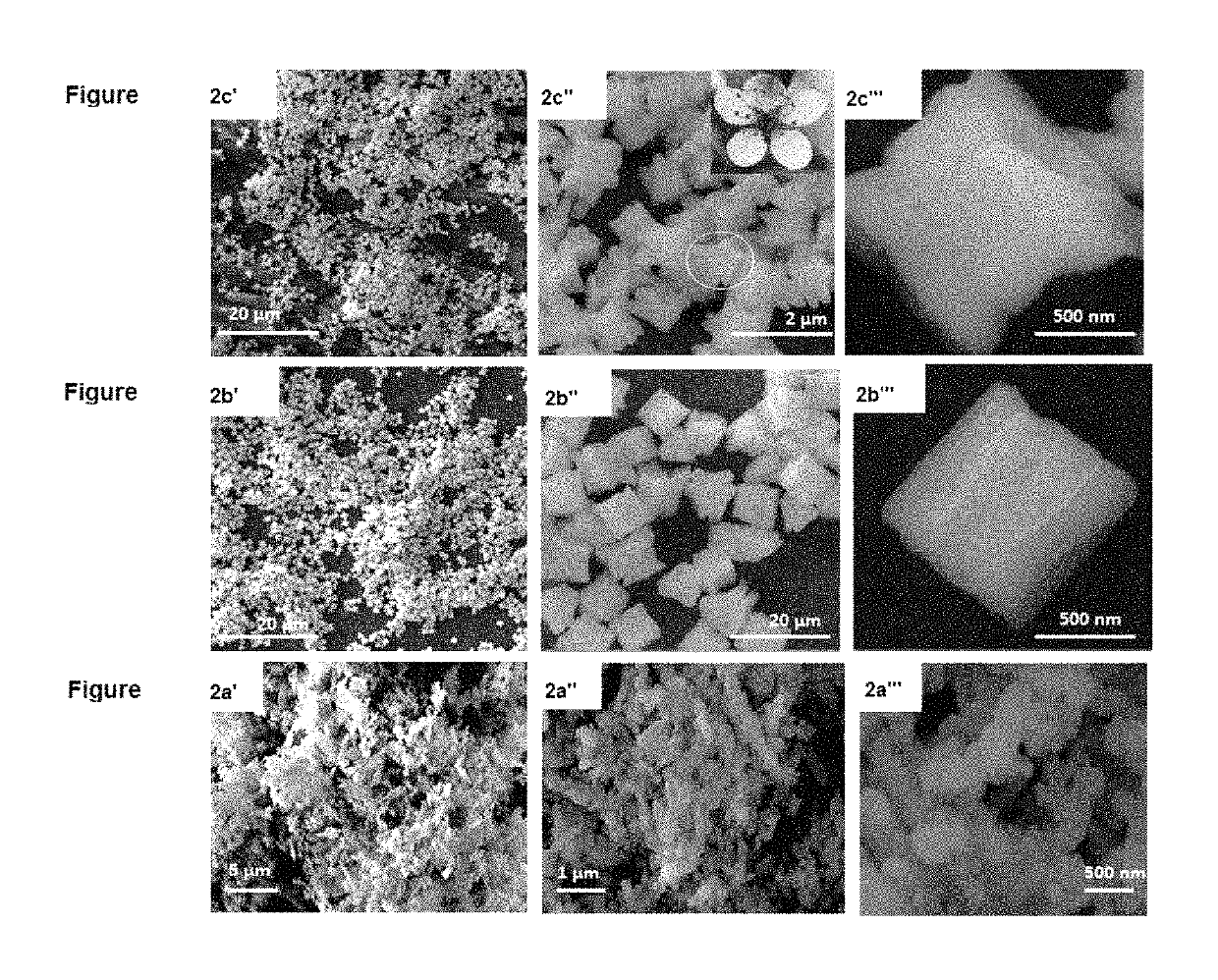Low temperature hydrothermal method for the preparation of LaCO3OH nanoparticles
a hydrothermal method and low temperature technology, applied in the direction of catalyst activation/preparation, metal/metal-oxide/metal-hydroxide catalyst, inorganic chemistry, etc., can solve the problems of complex reaction mechanism, development of new routes for morphology-controlled crystal growth, and formation of essential defects such as calcium and oxygen vacancies, so as to reduce nitrogen oxide
- Summary
- Abstract
- Description
- Claims
- Application Information
AI Technical Summary
Benefits of technology
Problems solved by technology
Method used
Image
Examples
example 1
Analytical Methods:
[0070]X-ray diffraction (XRD) analyses were performed on a Bruker D8 Advance diffractometer system with an operating voltage of 40 kV and a current of 40 mA by using Cu Kα radiation (λ=1.5405 Å) and a graphite monochromator. The samples were investigated over the 20 range 10-80° at a scanning speed of 2 min−1. Fourier transform infrared (FT-IR) spectra were collected on a Bruker FT-IR spectrometer by using the KBr pellet technique. Thermal gravimetric analysis (TGA) analyses were carried out using a thermogravimetric analyzer (Discovery, TA, USA). A 5.0 mg sample was placed in an aluminum pan and heated from 30 to 600° C. under N2 at a heating rate of 10° C. / min. The morphologies and sizes of the resulting products were determined with field emission scanning electron microscopy (TESCAN LYRA3, Czech Republic). TEM images were recorded by using a transmission electron microscope (JEOL, JEM 2011) operated at 200 kV with a 4 k×4 k CCD camera (Ultra Scan 400SP, Gatan)...
example 2
Hydrothermal Method for the Synthesis of LaCO3OH:
[0071]A reaction mixture of La(NO3)3.6H2O Sigma-Aldrich Co.) and Ca(NO3)2.4H2O (Fluka) in a molar ratio of 95:5 is obtained by mixing solutions of La(NO3)3 and Ca(NO3)2 dissolved in deionized water. To the reaction mixture, a sufficient amount of (NH4)2CO3 solution (4.1 mol / ml, Merck) is added to co-precipitate the metal ions by adjusting the pH to about 8.5. In a typical preparation, 1 ml solution of 6.8 mg (0.029 mmol) of Ca(NO3)2 in water is added to 15 ml solution of 0.25 g (0.57 mmol) of La(NO3)3.6H2O in water followed by the addition of 0.017 mol (NH4)2CO3 solution. The pH of the reaction mixture is adjusted to about 8.5 with ammonium carbonate and the reaction mixture is incubated and vigorously stirred for 12 hours while maintaining the pH at about 8.5 by adding NH3.H2O (25 wt %) or a HNO3 (1 M) solution. The reaction mixture is transferred to a plastic container with an inner volume of 500 ml, and then the plastic container w...
example 3
Characterization of the Nanoparticles:
[0073](a) X-Ray Diffraction:
[0074]FIG. 1 shows the XRD patterns collected from the LC-12, LC-24, and LC-48 as-synthesized samples. The diffraction peaks in these patterns are very similar. The molar ratio of La:Ca=95:5 mol % in all these samples, but they differ in the hydrothermal reaction time. The peak intensities increase as the hydrothermal reaction time increases from 12 h to 48 h; they are very sharp and intense, which indicates higher crystallinity and is in agreement with the SEM observations. All the peaks were slightly broad at the base of the peaks, in particular, for the sample prepared by 12 h reaction time. Moreover, the two split peaks at a two-theta value of 430 have similar intensities [FIGS. 1 (a) and (b)]. The intensity of this split peak increases with increases in the reaction time, and the peak at 43.30 becomes more intense than that at 43.20 [FIG. 1(c)]. The highly crystalline peaks in FIGS. 1 (a), (b), and (c) can be ind...
PUM
| Property | Measurement | Unit |
|---|---|---|
| Temperature | aaaaa | aaaaa |
| Temperature | aaaaa | aaaaa |
| Temperature | aaaaa | aaaaa |
Abstract
Description
Claims
Application Information
 Login to View More
Login to View More - R&D
- Intellectual Property
- Life Sciences
- Materials
- Tech Scout
- Unparalleled Data Quality
- Higher Quality Content
- 60% Fewer Hallucinations
Browse by: Latest US Patents, China's latest patents, Technical Efficacy Thesaurus, Application Domain, Technology Topic, Popular Technical Reports.
© 2025 PatSnap. All rights reserved.Legal|Privacy policy|Modern Slavery Act Transparency Statement|Sitemap|About US| Contact US: help@patsnap.com



